Published
on 31
Oct 2017
|
All rights reserved.
|
|
|
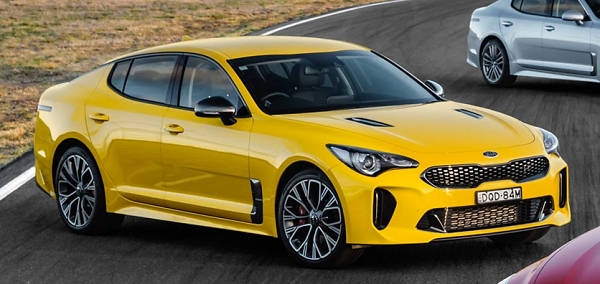
|
|
The
Korean takes its fight to an image-conscious segment. Is it ready?
|
|
Until now, 4-door coupes
remain a niche concept played by German premium car makers. Mercedes
has CLA and CLS, BMW has 4- and 6-Series Gran Coupe, while Audi has A5
and A7 Sportback. You might take the last generation Jaguar XF or the
current XE into account, or to lesser extent Volkswagen CC and the
recent Arteon – although their mechanical layouts are not so sporty.
That is to say, 4-door coupes are classy products that sell on brand
and image. Now Kia wants to make a breakthrough with its new Stinger
GT. What? You might ask. Even though Kia (as well as Hyundai) has been
rising quickly through the rank in recent years, it is not considered
to be an equal of BMW, Mercedes and Audi. For example, the recent K7
(Cadenza) and K9 (Quoris) are no more than mediocre by the standards of
luxury cars. How come it take the fight to an even more image-conscious
segment like 4-door coupes? Is it really ready?
Think about it, if it succeeds to get close to its European premium
rivals – not necessarily better or equal them, but good enough to be
mentioned in the same sentences – it could change the perception of the
brand overnight. From this perspective, the investment is worthwhile.
And what an investment of time and money! The work could be traced back
to at least 2011, when the company demonstrated the GT concept in
Frankfurt motor show. It was a very beautiful 4-door luxury coupe that
looked more like what Maserati or Giugiaro would do than anything
possible by the Korean. It was a pet project of group design chief
Peter Schreyer, and he apparently got the support of the management
board to realize the car. Interestingly, despite 6 long years
separating them, the production car changed little from the GT concept.
Its beautiful FR fastback profile is kept intact, while the 3.3-liter
twin-turbo V6 really made into production. However, just a good style
and powerful engine are not sufficient. It takes also a good chassis to
match the European best. That is why in 2014 Hyundai group headhunted
BMW M division engineering chief Albert Biermann. His first assignments
were Hyundai i30N, Kia Stinger GT and Hyundai Genesis G70 – the last
two are actually sister cars based on the same dedicated platform.
Extensive testing in Nurburgring makes sure the car rides and handles
as well as Biermann did for his ex-employer, hopefully.
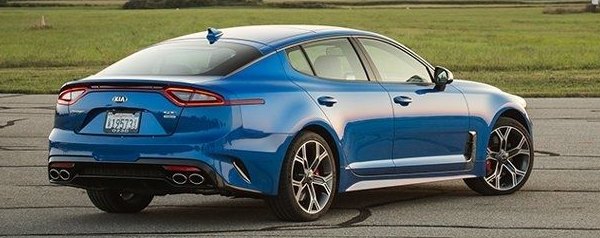
|
|
Triangular
C-pillar gives it the Maserati feel.
|
|
However, first of all we have to appreciate its styling. At the first
glance from pictures it looks as if a lightly polished K5 (Optima), but
in
fact its proportion is very different because of the FR platform
underpinning it. Its bonnet is quite long, cabin is set rearward, and
the shoulders are more pronounced. The glasshouse more tappered and the
overall shape is a lot sleeker. Highlight is the triangular C-pillar,
which gives it the Maserati feel. Like the old Maserati 3200GT or
Quattroporte V, it needs no dramatic curves or sharp crease lines to
appeal, just subtle curves and elegant surfaces are sufficient to
deliver beauty – and I am sure this beauty will be enduring. Its front
end avoids the questionable taste of Lexus, Infiniti or even Audi. The
new Tiger-nose fascia with mesh grille gives it enough character to
stop the criticisms saying it copied BMW’s double-kidney nose. Overall,
its exterior design is more attractive than either the 4-Series Gran
Coupe or A5 Sportback. Peter Schreyer once again makes his compatriots
regretting losing him!
The Stinger GT is quite a large car. Despite aiming at 4-Series Gran
Coupe and A5 Sportback, it is sized halfway between the 4- and 5-Series
– maybe closer to the latter. It is 4830mm in length, 1870mm in width
and 1400mm in height, with a wheelbase of 2905mm. These eclipse the
4-Series Gran Coupe by 192mm, 45mm, 11mm and 95mm, respectively.
Apparently, it follows the traditional Korean formula to offer more
space and equipment for the money. However, the Stinger still undercuts
the equivalent BMW and Audi by a substantial margin – for example, the
flagship V6 model starts at £40,000 in the UK market, 20 percent
cheaper than a comparably equipped 440i Gran Coupe. This means, even
though Kia is willing to sacrifice a thick profit margin enjoyed by its
rivals, the Stinger needs to watch production costs carefully.
Consequently, the monocoque chassis is all-steel, although 55 percent
comprises of high-strength steel to guarantee high rigidity. There is
hardly any aluminum or magnesium in its chassis. Coupling this to its
XL size, you don’t need
to be a genius to guess that it is heavy. The flagship model with RWD
tips the scale at 1785 kg, or 170 kg more than a 440i Gran Coupe. The
base 2.0T model stands at 1650kg, 120 heftier than 430i Gran Coupe.
This drags down its performance and fuel economy somewhat.
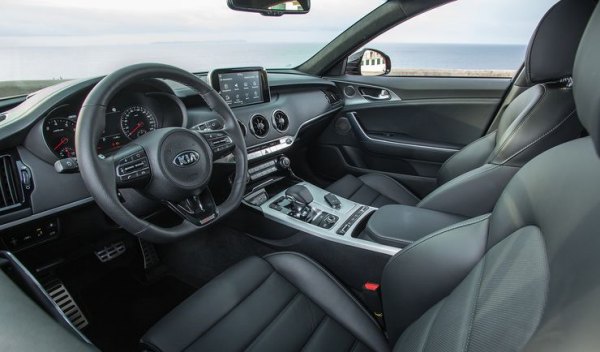
|
|
Its perception
of quality is no match for Audi, somewhat below BMW and about on a par
with Jaguar.
|
|
On the flipside, the extra dimensions and steel give its occupants
plenty of space. Rear passengers enjoy more legroom than the case of
4-Series Gran Coupe or A5 Sportback. Like its rivals, rear headroom is
slightly compromised by the sloping roof liner, but a pair of 5’10”
guys should have no complaints. Up front, the driving position is good
and low enough. The dashboard design is sporty, with the center console
oriented slightly towards the driver in BMW-style. 3 circular air vents
occupy the prominent area of the console and resemble Ferrari’s
interior design, while an 8-inch touchscreen stands above the console
for better ergonomics. However, to make possible the keener prices,
build quality is inevitably sacrificed a little bit. The upper
dashboard and door panels are soft plastics that look like leather, but
not as great to touch. More problematic, most switchgears feel
plasticky, including the gearshift paddles and drive mode selector. The
satin chrome accents are too understated to lift the ambience of the
otherwise dark cabin. Likewise, the infotainment system and audio
system are more suitable to mainstream brands than a premium one.
Overall, its perception of quality is no match for Audi, somewhat below
BMW and about on a par with Jaguar.

|
|
Given
a longer wheelbase, rear passengers enjoy more legroom than its rivals.
|
|
The Stinger’s rear-wheel-drive platform is shared with the upcoming
Genesis G70 (Hyundai's 3-Series fighter), but
it is also related to the larger Genesis G80 and G90. Like those cars,
it is
available with an electronic-controlled AWD system which engages the
front axle only when needed. It also rides on 5-link rear suspensions,
but the multi-link front suspensions are replaced with lighter
MacPherson struts like BMW. Fitted as standard are adaptive dampers, a
mechanical LSD (for RWD models) and, for the first time on Kia,
selectable driving modes. To cope with its mass, the V6 model employs
stronger Brembo brakes consisting of 350mm vented discs and 4-piston
calipers up front, and 340mm vented discs and 2-pot calipers at the
rear. Likewise, the 255/35ZR19 rear rubbers reflect its extra load, and
they are Michelin Pilot Sport 4 instead of the usual cheap Hankook or
Kumho. Weight distribution is not quite as good as BMW or Jaguar
though, with 53:47 front to rear for V6 or 52:48 for four-cylinder
model, but that is still easily better than Audi.
Only 2 engines are offered, and both are taken from the parts pool. The
base 2-liter GDI turbo produces 255 hp and 260 lbft of torque, which is
good enough to match BMW 430i or Audi A5 Sportback 2.0TFSI, but the
heft of the car means you had better to opt for the Lambda II 3.3-liter
GDI twin-turbo V6, which comes straight from Genesis G80 Sport and G90.
It produces a remarkable 370 hp and 376 lbft of torque, significantly
more than 440i (326hp / 332 lbft), S5 Sportback (354hp / 369 lbft) or
XE S (340hp / 332 lbft), if not the pricey Mercedes C43 (367hp / 382
lbft). Coupling to Hyundai's own 8-speed automatic transmission, it is
good for 0-60 mph in 4.7 seconds according to Kia, which is on a par
with its rivals. Moreover, the car’s top speed is set at 167 mph,
deliberately higher than the European norm of 155 mph.
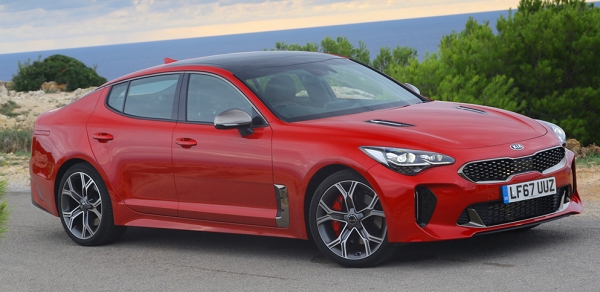 |
|
Good
power from the twin-turbo V6, but 8-speed auto is the Achilles' heel...
|
|
On the road, the base 2.0T model is quite slow, taking over 6 seconds
to do 0-60 mph sprint even though the factory claims 5.7 seconds.
Although the four-cylinder is quiet and refined enough, it does not
feel as responsive low down as BMW or Audi engines. The weight of the
car does not help either, ditto the slow-shifting 8-speed automatic,
which is simply not in the same league as the famous ZF units on its
rivals.
The 3.3-liter twin-turbo V6 is much better. Given its extra capacity
(10 percent more than its rivals) and heavier boost pressure, it feels
especially punchy in the mid-range. At low rpm there is some old-school
turbo lag that its rivals managed to rectify, because it has two turbos
instead of a twin-scroll turbo or supercharger. However, keep it
spinning and you can enjoy a relentless shove that easily propels the
Kia from rest to 100 mph under 12 seconds. Unfortunately, the V6
doesn’t sing. Its exhaust note is quiet and monotone, so dull that no
wonder Kia uses sound synthesizer to pump artificial noise into the
cabin. The same 8-speed automatic gearbox is again an Achilles’ heel.
It works fine in Comfort mode, but when you want more excitement and
switch to Sport mode, its response is disappointingly slow. Change to
paddle shift mode improves things a little bit, but it still upshifts
automatically near the 6500 rpm redline. Moreover, if you don’t use it
for 5 seconds, it will revert to automatic mode, which is annoying. A
sporty car like this deserves a better transmission.
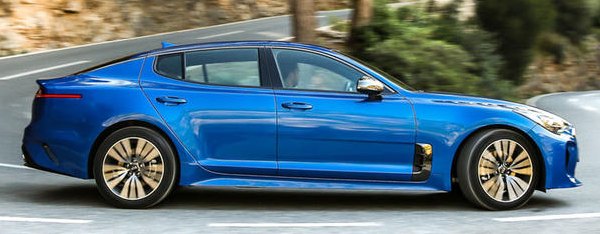 |
|
Kia is going to
be a winner, because from now on it will be often mentioned in the same
sentences as BMW, Audi and Jaguar.
|
|
Maybe Albert Biermann had nothing to do with the car’s powertrain. His
expertise is in chassis, and thankfully this is reflected on the car’s
ride and handling. Mind you, the Stinger GT cannot fully let you forget
its excessive weight and size, but it masks them reasonably well. The
suspension manages to absorb bumps, potholes and ridges without fuss.
It feels supple and well damped over long distances, while the cabin is
quiet at cruising speed, no wonder Kia names it GT. On a stretch of
mountain road with adaptive damping set to Sport mode, it maintains
good body control. There may be a touch more body roll than a 4-Series
or S5, but it remains a pleasure to drive in mood. The steering is
direct and accurate, if lack of feel. The Brembo brakes are outstanding
in power and feel.
The chassis balances well in corner. There is good front-end grip to
keep the balance neutral. You may even switch off the traction control
(which will still intervene in emergency), use throttle pedal to induce
a bit oversteer. That said, if the power recovers from turbo lag at
this moment, the slide could catch you a surprise. Also, mid-corner
bumps could unsettle its rear suspension, thus its at-the-limit
handling needs extra care. In flatter, high speed corner, the Stinger
runs into understeer earlier than a 4-Series or S5, reminding you that
after all it has too much weight to carry.
This means by objective measures the Stinger GT is still not good
enough to challenge its established European rivals. However, taking
its stylish look, roomier cabin and outstanding value for money into
account, its prospect is very promising. Regardless of sales result,
Kia is going to be a winner, because from now on it will be often
mentioned in the same sentences as BMW, Audi, Mercedes and Jaguar.
|
Verdict:     |
|